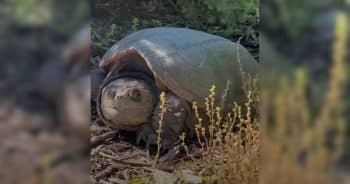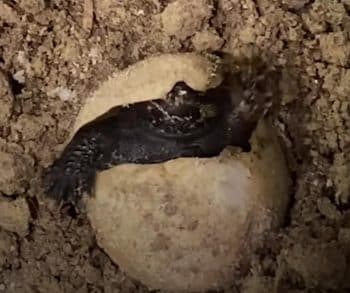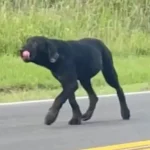In the serene suburbs of New Jersey, where life typically moves at a predictable pace, one unsuspecting family found themselves in the middle of a rare wildlife event. What began as an ordinary afternoon for the Iero family turned into an unforgettable lesson in nature, compassion, and conservation—all thanks to a remarkable visitor wandering into their backyard: a giant snapping turtle.
Frank Iero’s wife was the first to notice something out of place in their garden. What initially appeared to be an oddly shaped rock slowly revealed itself to be alive. As the family approached, they discovered a massive snapping turtle lumbering through their mulch bed. Mesmerized by its calm presence and impressive size, the Ieros quickly grew attached to the reptile and affectionately named her Snippy.
Unknown to them at the time, Snippy wasn’t just wandering—she had a purpose. With slow, careful movements, she began to dig into the soft earth beneath the mulch. The Ieros unknowingly witnessed a rare and intimate moment: Snippy was laying her eggs, a process that snapping turtles undertake with great secrecy and instinctual precision.
That night, nature took a turn as a heavy storm swept through the region. The next morning, Frank ventured into the garden to assess any weather damage. To his surprise, the mulch had been partially washed away, revealing a cluster of small, white, ping-pong ball-like spheres—snapping turtle eggs. Realizing what Snippy had left behind, Frank was struck by an overwhelming sense of responsibility.
“It felt like a Horton moment,” Frank recalled, referencing Horton Hatches the Egg. Inspired by the story’s message of care and loyalty, the Iero family vowed to protect the vulnerable embryos left behind in their yard.
They began by researching snapping turtle egg care and incubation, learning how critical temperature and environment could be for successful hatching. With only basic tools and a lot of determination, the Ieros created a makeshift backyard nursery. They filled containers with fine-grain sand, installed a ceramic heat lamp, and gently relocated each delicate egg.
- The children kept journals, documenting temperature changes and potential movement inside the eggs.
- The family maintained warmth around the clock to mimic natural incubation conditions.
- Hope remained high, even with uncertainty following the storm.
Weeks passed, and just when doubt began to creep in, the long-awaited miracle occurred. Cracks formed on the eggshells, and one by one, baby snapping turtles emerged—tiny, determined, and full of life. The family gleefully celebrated each hatchling, even giving them names and recognizing their distinct personalities.
They learned that after hatching, each baby turtle retains a yolk sac, which provides essential nutrients for the first few days. During this time, the hatchlings remained safely in the nursery until they fully absorbed their yolk sacs and became strong enough for release.
Armed with knowledge gleaned from local reptile experts, the Ieros prepared for one final, meaningful step—returning the turtles to their natural habitat. The family carried the young hatchlings in small containers to a nearby pond, one that offered clean water, plants, and shelter.
As the turtles approached the water’s edge, instinct took over. Each one began to crawl toward the pond, eventually disappearing into its depths. For the Ieros, it was a moving farewell. Months of dedication, love, and stewardship culminated in a beautiful moment of release. The turtles were free, and the family left with their hearts full and their backyard forever transformed.
This incredible event in a suburban garden serves as a reminder of how nature can unexpectedly enter our lives—teaching empathy, encouraging learning, and inspiring a deep respect for the wild creatures that share our world.










Facebook Comments